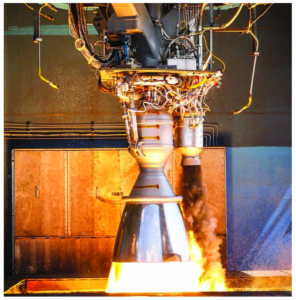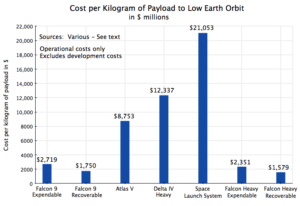How Viable is Reusable Rocket Technology?
A reusable launch vehicle is defined by a ScienceDirect paper as a rocket that can be recovered and launched multiple times (Kasselouri, Patroklos, & Tsikopoulos, 2023). Smaller parts like engines and boosters can also be reused, reducing launch costs significantly. In recent years, companies like SpaceX, Blue Origin, and others have been at the forefront of this technology, successfully demonstrating the ability to recover and reuse rocket stages after launch. After understanding what makes up a rocket and which parts we can reuse, we can discuss the efficacy of the technology and how it can be implemented in the future.
What is in a Rocket?
A typical rocket is made of four key components, each of which contributes crucially to its performance. The most important part of a rocket is the propulsion system, which uses engines that generate thrust to lift the vehicle off the ground. Engines are often the most expensive part of a rocket, so reusing them is particularly advantageous (Kennedy & Adams, 2017). Companies like SpaceX have successfully refurbished their Merlin engines after each flight, ensuring that they remain reliable for successive launches (MIT News, 2023).
The second component of a rocket is its stages. Rockets are usually built in stages, each one designed specifically to handle a particular set of tasks in the launch sequence. The first stage lifts the rocket through the atmosphere, while the next stages take the rocket to space. These stages detach after their purpose has been served, in order to reduce the mass of the rocket and therefore save fuel. Reusable first stages, like those on the Falcon 9, can land back on Earth and land vertically, allowing them to be relaunched (KDC Resource, n.d.). This is one of the more recent and eye-catching developments in reusable rocket technology. Since 2015, this innovation has been increasing in efficiency and popularity.
Avionics are the third essential element of a rocket. This makes up all of the electronic systems used for navigation, control, and communication. Since avionics are relatively inexpensive and easier to replace compared to other parts of the rocket, not much effort has been made to revolutionize their reusability (Kennedy & Adams, 2017). However, there have been some hardware and software improvements put in place which have slowly worked to improve this aspect of reusable rockets.
The final part of the rocket is its payload – what is actually being carried into space. This could range from satellites, scientific instruments, astronaut crews, or supplies. While the payload itself is obviously not reused, the design and integration processes for carrying different payloads can benefit from the knowledge gained through multiple launches.
Figure 1
Firing test of a Merlin Engine at SpaceX

Source: ResearchGate
The Viability of Reusing Rocket Components
The feasibility of reusing rocket components hinges on several factors, including cost, safety, and sustainability. Reusing engines and first stages significantly lowers the cost per launch, making space more accessible to commercial ventures. For example, the successful reuse of Falcon 9 first stages has led to a reduction in launch costs from tens of millions of dollars to as low as $2 million (Kasselouri, Patroklos, & Tsikopoulos, 2023). Elon Musk also stated in May of 2020 that SpaceX spent about one billion dollars to develop a reuse program. Since then, boosters that cost SpaceX $30 million to build now only cost them $250 thousand dollars to refurbish for the next flight. Over the course of years, that $1 billion will pay itself off and lead to a profit for SpaceX among other companies. By investing in reusable rocket technology, these companies will save themselves billions in the long run (KDC Resource, n.d.).
Although we know that reusing rocket components is beneficial from a purely economic standpoint, there are always concerns about its safety. According to NASA, after each launch and recovery, rocket components, especially engines and landing mechanisms, must be thoroughly inspected for any signs of damage. Even microscopic cracks could be catastrophic when the force of an accelerating rocket is applied to one area (Kennedy & Adams, 2017). The reason that SpaceX still spends so much money on the refurbishing of parts is to ensure that reused components meet the same safety standards as newly manufactured parts. Each reused component is certified for safety, often requiring multiple inspections and, in some cases, component replacements. External factors like weather, space debris, and variations in atmospheric conditions can also affect the safety and performance of reused rockets. As technology improves and more data is gathered from repeated launches, the safety record of reusable rockets is likely to improve, further solidifying their role in the future of space exploration and making reusable rocket technology even more efficient.
Another one of the major advantages of reusable rockets is the reduction of waste and manufacturing resources. By reusing components, fewer new rockets need to be built, reducing the waste caused by materials production, rocket assembly, and launch emissions (Keronite, n.d.). By reusing rocket parts multiple times, the demand for raw materials like aluminum, titanium, and carbon composites decreases. Although this might not seem very significant, this reduction lessens the environmental impact of mining, refining, and transporting these materials, which adds up quickly.
In addition, single-use rockets leave behind debris in space, including spent rocket stages and other materials that remain in orbit. Reusable rockets which return to Earth after launch help reduce the accumulation of space debris. This is crucial in preventing collisions between space objects and maintaining safe orbits for satellites and future space missions (Kasselouri, Patroklos, & Tsikopoulos, 2023). As reusable rocket technology continues to improve, it supports the broader goal of sustainable space exploration. This will be especially important as the frequency of space launches increases due to commercial ventures, scientific missions, and the development of space tourism.
Figure 2
The Economics of Rocket and Spacecraft Development

Source: An Economic Sense
Conclusion
Reusable rocket technology is one step in the right direction when it comes to responsible space travel. After years of hurting the environment and unnecessarily spending funding, it has proven to be one of the most significant advancements in space exploration. It has contributed to making space exploration more cost-effective, safe, and environmentally responsible. As companies like SpaceX and BlueOrigin continue the innovation in this growing field, we will inevitably see even more progress in efficient space exploration.
References and Sources
Kasselouri, V., Patroklos, M., & Tsikopoulos, G. (2023). Technical and economic viability of reusable rockets: A review. Energy, 278, 127578. https://doi.org/10.1016/j.energy.2023.127578
KDC Resource. (n.d.). The rise of reusable rockets: Transforming the economics of space travel. KDC Resource. https://www.kdcresource.com/insights-events/the-rise-of-reusable-rockets-transforming-the-economics-of-space-travel/
Kennedy, K. J., & Adams, C. C. (2017). The long-term benefits of reusable launch vehicles: A NASA perspective (NASA Technical Report No. 20170000606). NASA Technical Reports Server. https://ntrs.nasa.gov/api/citations/20170000606/downloads/20170000606.pdf
Keronite. (n.d.). How materials scientists have made reusable spacecraft a reality. Keronite. https://blog.keronite.com/how-materials-scientists-have-made-reusable-spacecraft-a-reality
MIT News. (2023, November 28). Boosting rocket reliability at the material level. Massachusetts Institute of Technology. https://news.mit.edu/2023/boosting-rocket-reliability-material-level-1128
1 thoughts on “How Viable is Reusable Rocket Technology?”